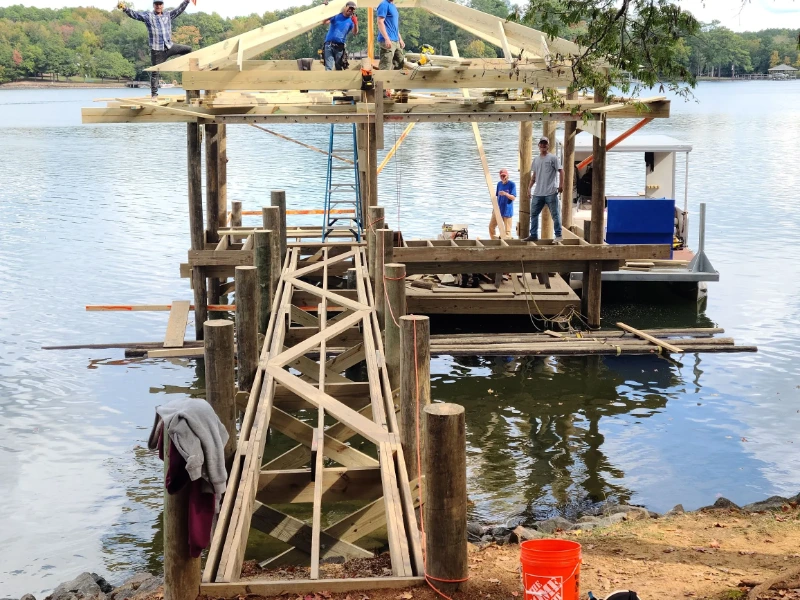Necessary Guide to Affordable Dock Repairs for Homeowners
Effective Dock Repair Service Techniques: Guaranteeing Architectural Honesty
Making certain the architectural stability of docks through effective repair work methods is critical for the long life and safety of marine centers. This entails a multi-faceted method beginning with comprehensive assessments using advanced modern technologies like sonar tools and from another location ran cars (ROVs) to detect both noticeable and concealed problems. Subsequently, selecting the appropriate fixing products, such as composite products and corrosion-resistant alloys, is vital for sturdiness. Structural support approaches, including the implementation of cross-bracing systems and load-distribution plates, play a vital function in mitigating anxiety factors. Nevertheless, the importance of these strategies ends up being apparent when exploring innovative fixing approaches and preventative maintenance techniques.
Assessing Dock Damage
Assessing dock damages is an important initial step in making certain the architectural honesty and safety of any docking facility. This preliminary assessment includes a detailed examination to determine both visible and covert damages. Secret facets to analyze consist of the dock's foundation, pilings, decking, and equipment. Each element must be scrutinized for signs of wear, rot, deterioration, or various other types of destruction that might endanger the architectural integrity.
Architectural engineers or qualified examiners commonly carry out these analyses using specialized methods and devices. As an example, underwater evaluations might utilize sonar equipment or from another location operated automobiles (ROVs) to detect immersed damage. Above water, visual evaluations are matched by utilizing dampness meters and other diagnostic devices to discover underlying problems not promptly visible to the naked eye.

Choosing Repair Service Products
Choosing the suitable fixing materials is a crucial action in the dock repair procedure, one that straight influences the longevity and performance of the fixed framework. Material option must be driven by factors such as ecological conditions, load-bearing needs, and compatibility with existing dock elements. Timber is a conventional choice for docks due to its all-natural strength and visual allure. Choosing the appropriate type of wood, such as pressure-treated lumber or normally rot-resistant types like cedar or teak, is important to withstand marine atmospheres.
Along with timber, composite products are increasingly preferred because of their longevity and low upkeep needs. Composites, generally made from a mix of plastic and wood fibers, supply exceptional resistance to rot, bugs, and UV damages. For steel anchors, picking corrosion-resistant alloys such as galvanized steel or marine-grade aluminum is vital to prevent rust and ensure architectural stability in saline water conditions.
Epoxy materials and marine-grade sealers are indispensable for repairing fractures and securing joints, giving a waterproof obstacle and improving the dock's general strength. By meticulously selecting high-grade materials, dock repair work can achieve resilient results, consequently securing versus future deterioration and ensuring secure, dependable use.
Structural Reinforcement Techniques
Efficient structural support techniques are critical in making certain the security and long life of dock fixings. One essential method entails making use of steel or composite reinforcement bars (rebar) within concrete frameworks. Rebar supplies added tensile stamina, avoiding fractures and dispersing loads extra uniformly. This technique is specifically effective for docks subjected to heavy tons or extreme environmental problems.
One navigate here more necessary method is the application of fiber-reinforced polymers (FRP) These products offer high strength-to-weight proportions and exceptional resistance to rust, making them suitable for enhancing concrete or wooden docks. FRP can be applied in sheets or strips and bonded with epoxy materials to boost structural stability.
Bracing and securing systems additionally play a critical role in structural support. Cross-bracing, utilizing steel or wooden beams, can counteract side pressures, decreasing persuading and motion. Anchoring systems, such as helical piers or driven piles, provide a steady foundation by transferring loads to deeper, extra stable dirt layers.
Finally, the combination of load-distribution plates can aid distribute weight much more equally across the dock's surface, minimizing localized tension points. These methods jointly guarantee that anchors remain durable and secure, efficient in standing up to the rigors of their operational atmosphere.
Advanced Repair Methods

Another advanced strategy includes undersea welding, which permits repairs to be carried out without the requirement to dewater the area. This method is particularly useful for resolving architectural concerns in submerged dock elements, guaranteeing minimal disruption to operations. Improved welding strategies, paired with robot systems, deliver precision and reliability, therefore expanding the life expectancy of the dock.
Furthermore, cathodic defense systems are carried out to stop deterioration in metal dock frameworks. By utilizing sacrificial anodes or impressed present systems, these strategies properly minimize the electrochemical processes that bring about product damage.
Lastly, progressed surveillance innovations, such as architectural wellness monitoring (SHM) systems, provide real-time information on the condition of dock frameworks. These systems allow positive upkeep and timely treatments, inevitably making certain the long-lasting architectural honesty of the dock.
Upkeep and Prevention
Upkeep and prevention are essential principles that underpin the durability and safety and security of dock frameworks. Normal inspections are extremely important, enabling early discovery of wear and tear, possible weaknesses, and environmental effects. A positive approach, involving regular checks for deterioration, rot, and architectural changes, minimizes costly repair services and prolongs the dock's operational life.
Safety nets need to consist of using safety coatings to steel parts to defend against corrosion and utilizing treated wood to resist degeneration. Furthermore, ensuring correct drain and ventilation can avoid water build-up, which is a typical root cause of architectural degradation. Integrating top quality materials and sticking to maker guidelines throughout building and fixing stages likewise play critical duties in enhancing toughness.

Educating workers in dock upkeep finest practices ensures constant application of preventive steps. Leveraging technological breakthroughs, such as drones for evaluations and sensors for real-time tracking, can further enhance maintenance efforts. By prioritizing maintenance and prevention, dock owners can guarantee structural stability, functional security, and cost-effective administration over the dock's life-span.
Verdict
In conclusion, keeping the structural stability of marine centers necessitates detailed dock repair work strategies. Advanced fixing methods, combined with normal upkeep techniques, ensure the dock stays secure and operational under varied environmental conditions.
Ensuring the structural honesty of docks via efficient fixing strategies is extremely important for the longevity and safety of Learn More aquatic centers.Choosing the appropriate repair work products is a crucial step in the dock remediation procedure, one that straight influences the long life and efficiency of the repaired structure.Efficient structural support strategies are essential in making certain the security and long life of dock repair services. By focusing on upkeep and prevention, dock owners can ensure architectural stability, operational safety and security, and affordable management over the dock's life expectancy.
In verdict, maintaining the architectural honesty of marine facilities demands detailed dock repair work methods.